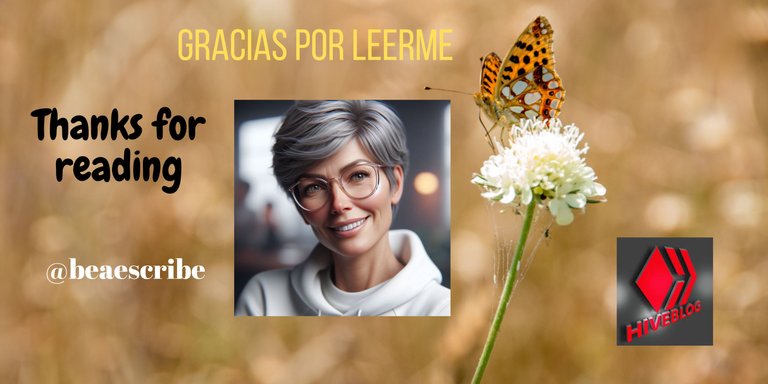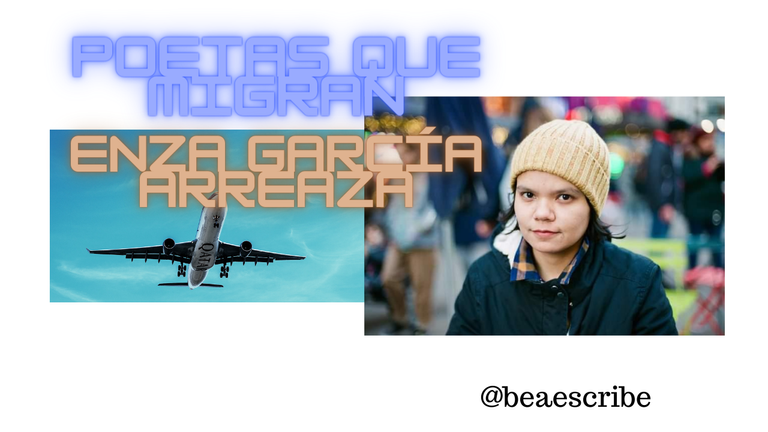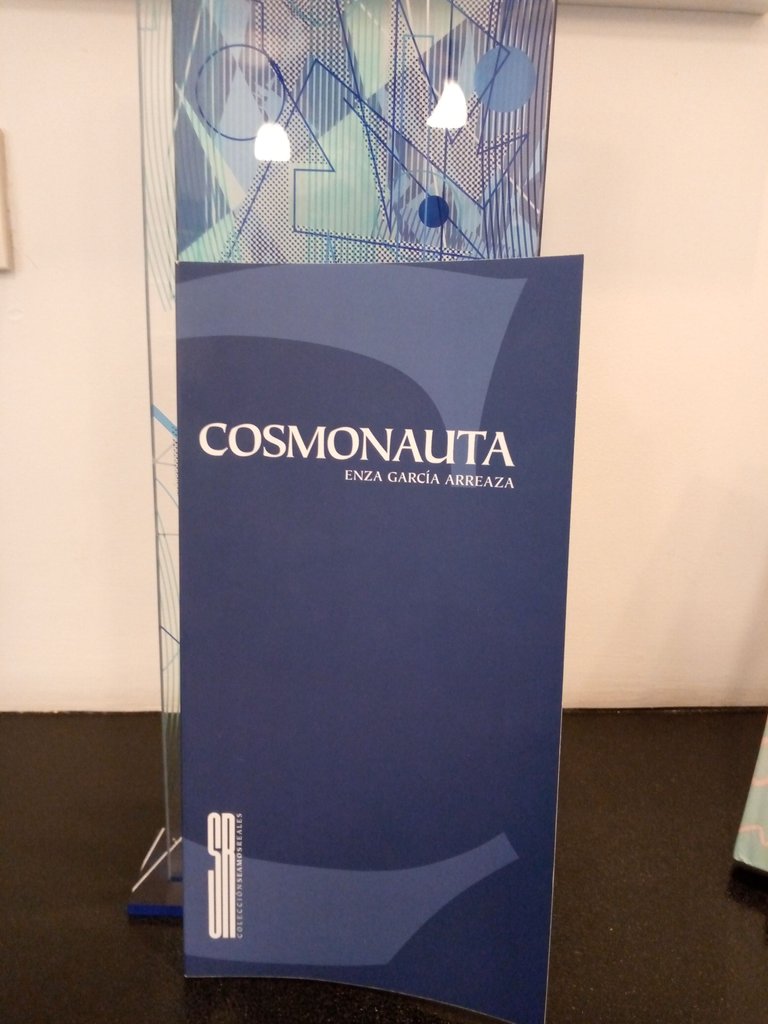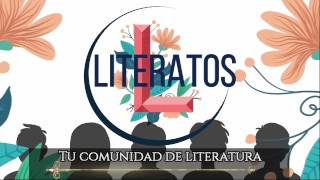Conocí a Enza García Arreaza en 2011, coincidimos en uno de los jamming poéticos que organizaban en el Ateneo de Caracas Georgina Ramírez, Keila Vall, Kira Kariakin y Graciela Yáñez Vicentini. En los jamming poéticos, a la manera de las jam session del jazz, los poetas establecen una suerte de diálogo, según el tema que haya abordado el último poeta que haya leído.
En aquel jamming poético en el que Enza y yo coincidimos participaron también los poetas Eleonora Requena, Leonardo Padrón, Alexis Romero y Adalber Salas. De aquel grupo de seis poetas que leímos ese día solamente yo permanezco en Venezuela. Eleonora y Alexis viven en Buenos Aires, Leonardo Padrón, Enza y Adalber en USA. Aquella fue una noche memorable de voces muy diversas que encontraron hilos secretos en común.
Aquella noche me sorprendió ver a Enza entre los participantes, había leído sobre ella como una joven narradora que había ganado premios, pero no sabía que escribía también poemas. Ese día, y en otros recitales en los que la escuché leer en esos años, me pareció una joven rebelde, que a pesar de su cara de niña, que aún conserva aunque ya no es tan joven, hablaba de sexo, de su cuerpo, sus experiencias, sus dudas frente a un mundo lleno de estereotipos y prejuicios, con una voz honesta, directa.
Una de las cosas que me han amigado con la obra de Enza García Arreaza es la sinergia entre la poesía y las artes visuales. Tanto en su primer libro “El animal intacto” (2015) como en “Cosmonauta” (2020) podemos disfrutar de esa sinergia. En el primero, encontramos una bellas ilustraciones realizadas por la autora, en blanco y negro. En el segundo, los textos, algunos en prosa, otros en verso, están acompañados por collages a color, que redimensionan los textos literarios. En los dos libros, ambos lenguajes dialogan conformando un universo propio que estimula la imaginación, la creatividad del lector.
En su primer libro “El animal intacto”, publicado en 2015 por la editorial colombiana Isla de Libros, encontramos algunos temas que van a ser centrales en su poética personal, uno de ellos es el tema de la madre. En “El animal intacto” se habla de la madre en un sentido genérico, y en “Cosmonauta”, publicado por La Poeteca de Caracas en 2020, la voz poética nos presenta una visión más personal de la madre, hace referencia a su madre. En cualquier caso la representación de la madre en su poesía se sale siempre del estereotipo, no es la madre amorosa que cuida y protege, puede ser incluso agresiva, la madre representada en “Cosmonauta” lo es:
“Todas las madres
se parecen un poco a William Blake
porque ser madre es tener visiones
y comerciar con los ángeles funestos
pensé que uno debe desconfiar respetuosamente
de aquella mujer que se abrió
para dejarte solo en el mundo”
(De “El animal intacto”)

“Mamá solía pegarme en la cara cuando yo era niña. Era la época de sus sandalias altas y de verse preciosa. Si estaba de mal humor, cualquier cosa la hacía estallar y aquello terminaba conmigo recibiendo un trancazo. Era agotador sobre todo aguantar las ganas de llorar en la calle. Tal vez por eso a veces, todavía, no me gusta hablar duro y me tropiezo de la manera más ridícula incluso en mi lengua materna.”
(De “Cosmonauta”, p. 13)
A mamá le encanta
hacer ruido en la cocina
el concepto de bataqueadera
se acuñó por ella
resulta curioso
que para ser alguien
con migrañas decididas
no sepa contenerse y viva
tirando las puertas o estrellando las ollas
tosiendo para que todo el mundo la vea
(De “Cosmonauta”, p. 36)
El animal que llevamos dentro

Como todos sabemos, gracias al psicoanálisis, la sociedad, pero también nuestro inconsciente, reprimen nuestra parte animal, instintiva. En su obra la autora nos muestra esa cierta voracidad que subyace en las relaciones humanas (“el hombre es el lobo del hombre”). Lo hace con una cierta ironía. No hay una victimización, cuando hace referencia a esa parte animal, depredadora o violenta. Lo expresa como quien sencillamente constata y expone una experiencia. Juega en ambos libros con esas figuras, fantasmas o miedos que habitan en los laberintos de nuestro inconsciente. Nos dice en “El animal intacto”:
Quienes aman que estés vivo
a veces tienen miedo
lo vivo es asedio
lo vivo puede ser salvaje
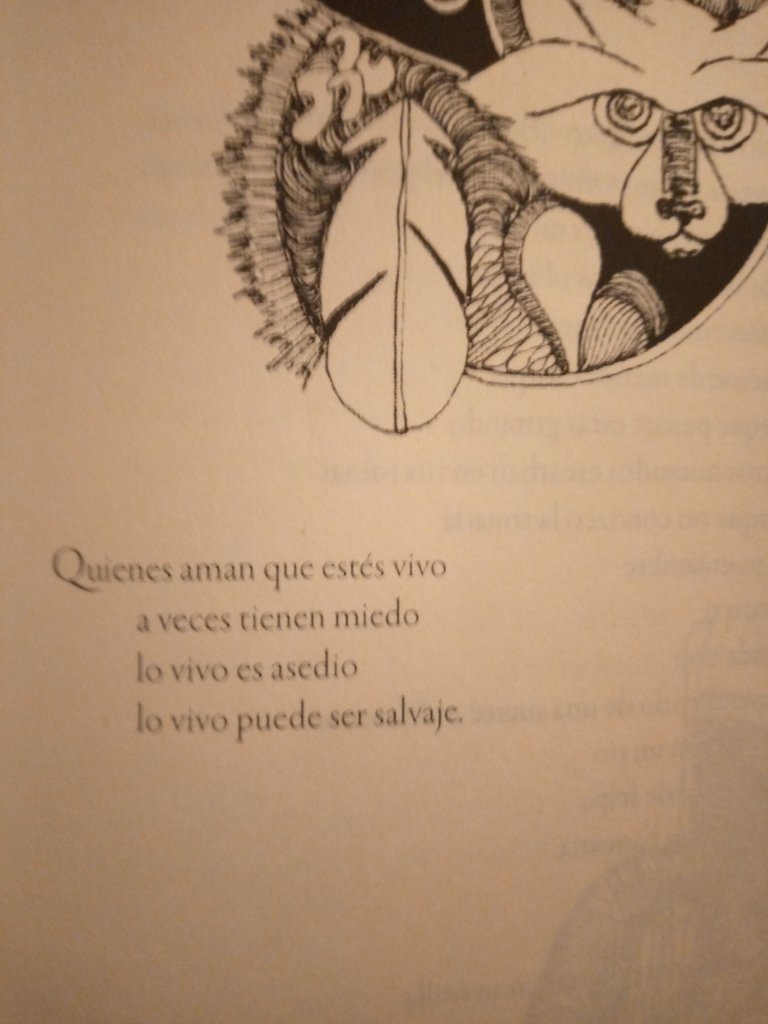
Foto del libro "El animal intacto" tomada con la cámara de mi teléfono móvil
“querido enrique[z]:
Un zorro es un incendio para quien olvidó buscar agua. Cada color es un triunfo del ojo sobre la anomia. Pero, ¿me engañaron o de verdad existen ritos para que la oscuridad no crezca demasiado? El pez globo dibuja círculos en la arena para conquistar a la hembra. Si yo fuera un pez globo dibujaría un cuadrado: no sé si quiero que me elijan o que me descifren. Durante siglos hemos creído que unas mariposas habitan en nuestro estómago cuando saltamos. Mientras tanto, la oscuridad protege el prestigio de animales apurados y tenaces. Estar en calma es ignorar que fuegos, ángeles y perfumes se buscan en un escarmiento, en una fe rara sobre la página.”
(De "Cosmonauta")
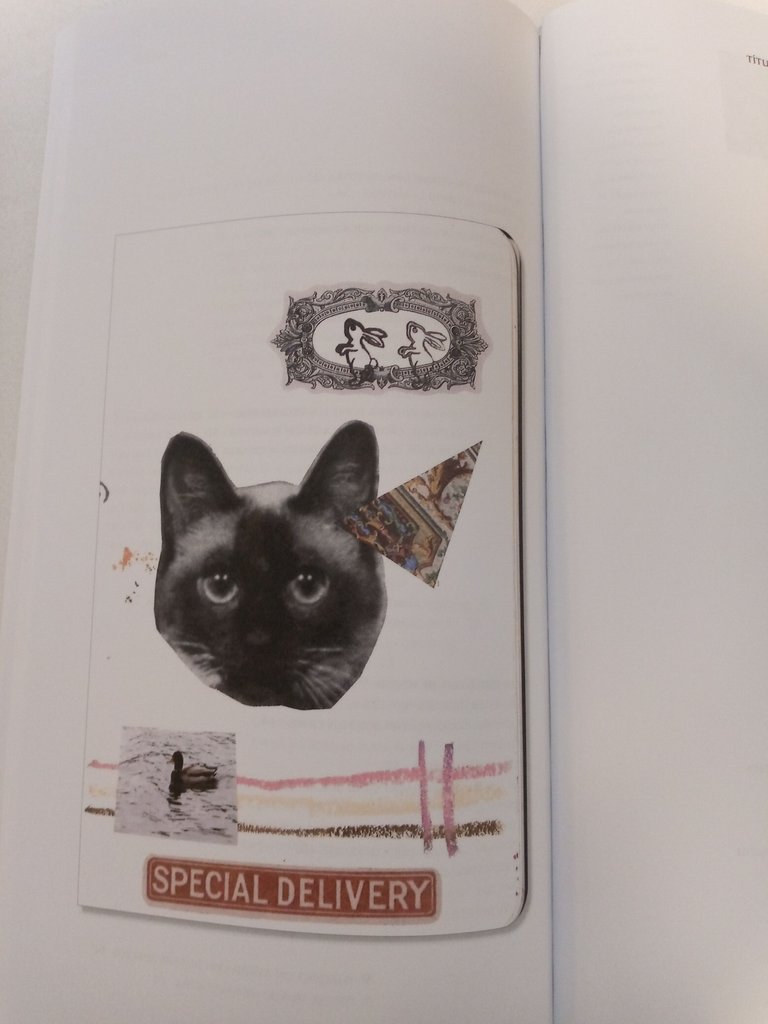
Foto del libro "Cosmonauta" tomada con la cámara de mi teléfono móvil
”Después de reírme con una tira de Liniers, en la que se aprecia a Enriqueta imaginando una ballena en su bañera –y no a cualquier ballena sino a Moby Dick– recordé en un sopetón emocionado que cuando era niña jugaba a que si volteaba de repente, a la hora de la ducha, me encontraría brotando de la pared a un tiburón con la boca abierta, con todos sus dientes sanguinarios hambrientos de mí.“
(De “Cosmonauta”)
El oficio de escribir

Otro referente que quiero destacar de la poesía de Enza García Arreaza, porque se reitera en sus dos libros publicados, es la reflexión sobre el acto mismo de escribir, el vínculo entre la realidad y el poema, la realidad pueden ser las personas, los objetos, las mascotas, pero también los fantasmas que nos habitan, como cualquier referente de nuestra realidad personal puede transformarse en poema, en texto, y configurar nuestro imaginario poético:
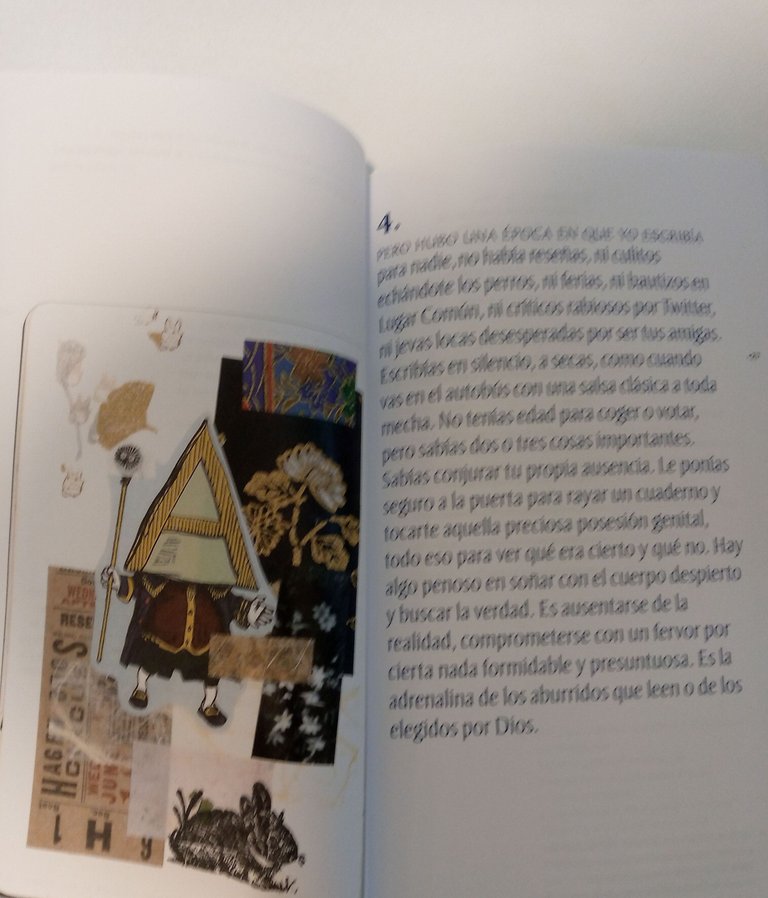
Foto del libro "Cosmonauta" tomada con la cámara de mi teléfono móvil
“porque sembramos un alma
en la soledad de los objetos
y ofrecemos un canto
al héroe de menor estirpe”
(“El animal intacto”)
“Los libros no son escudos
pero
me pasa que escribo
sobre cosas que no creo
invoco fantasmas
de ulular corrosivo
y me apego a certezas infantiles
y monstruosas
recuerdo a menudo en mis libros
cómo perdemos la cordura
frente a la fauna propia”
(“Animal intacto” )
“Mereces que piense el poema
antes de escribirlo.
Mereces un animal intacto
que se haya convencido
al fin.”
(“Animal intacto”)
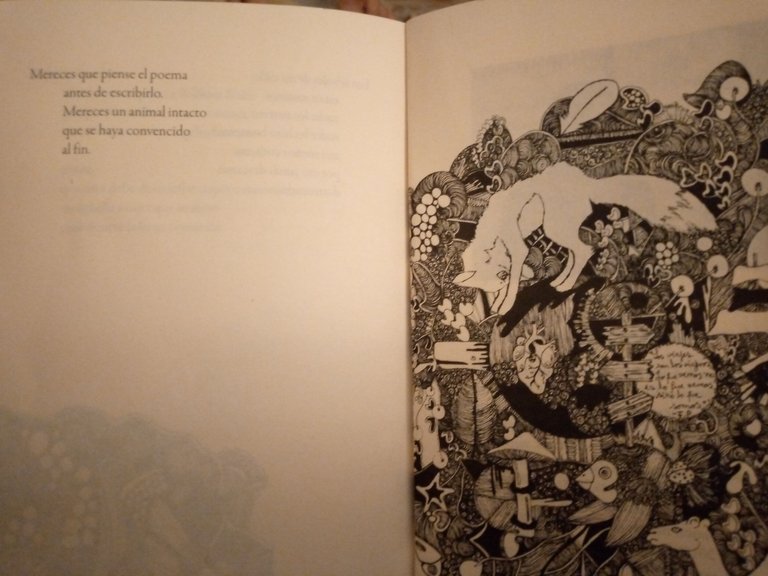
Foto del libro "El animal intacto" tomada con la cámara de mi teléfono móvil
“La mayoría de las historias que bosquejo no llegan al papel o a la pantalla, se conforman con transcurrir en esa licuadora ciclotímica que es mi interior. Puedo jurar que he escrito varias obras maestras en el autobús que me lleva desde el supermercado hasta la casa, en esos días raros en que no me asesinan o me roban, pero se deshacen en algún olvido; sólo me queda la certeza de haber sido otra persona, de haber vivido un deleite envidiable en silencio. Tal vez escribir no sea más que el falaz eufemismo del aislamiento, incluso cuando se está desesperado por atención”.
(“Cosmonauta”)
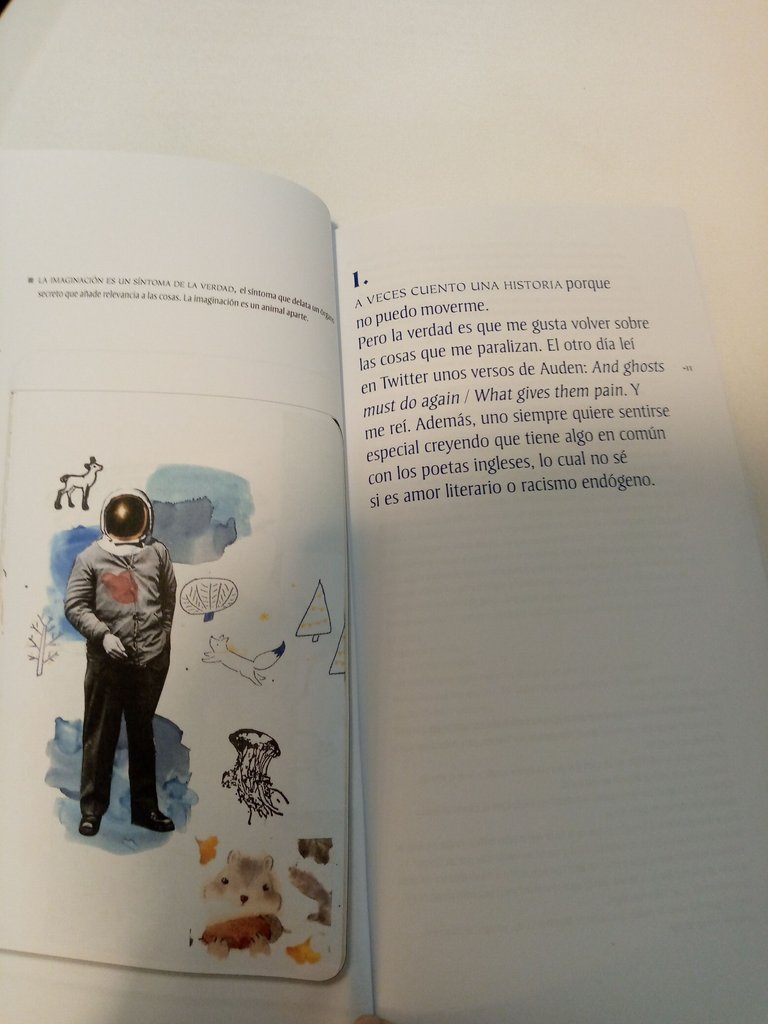
Foto del libro "Cosmonauta" tomada con la cámara de mi teléfono móvil
“Pero entonces a veces cuento una historia muy larga que es siempre la misma pero siempre me asfixia y es porque no puedo moverme. Escribir, en mí, es negociar el aire con la parálisis y el mundo. También es luchar contra el aburrimiento o la flojera, y últimamente contra la sensación de que es ridícula esta parte de mi vida frente a esa otra parte de mi vida donde corro por salvarme en un país sin antibióticos ni democracia”.
(“Cosmonauta”)
No todo es cruel asedio de lo real en la poesía de Enza García Arreaza, de pronto nos sorprende con un poema de hondo lirismo que nos habla del amor, entrelazando lo vivo que se transforma, sin perder su esencia, “la guitarra” que “primero fue bosque”:
La guitarra primero fue bosque
madera asida a la trémula tierra de las tribus
órbita de la oruga y el pájaro
sabrá el viento entre la fruta amanecida
a cuánto nido habrá salvado de ser presa
la guitarra primero fue soledad y recinto
pero la tonada ministro de la serpiente
quiso madurar deprisa el paraíso
y así la cuerda inventó la fogata o la barbarie
la curva de la hembra la cantata del vencido
guitarra fue espíritu repartiendo la humedad
y nos sentó junto al polen.
(para Leonardo González-Alcalá)
(De "El animal intacto")

Estimado lector, para cerrar este artículo sobre la obra poética de Enza García Arreaza te comparto un poema inédito que la autora tuvo la gentileza de enviarme:
"James está en el trabajo
me acompañan el olor de mis flatulencias
y algunos correos por responder
a veces quiero que la casa esté embrujada
yo no sé qué tiene el agua de este país
que james volviera del trabajo
y me encontrara poseída y dijera
ahora sí van a hacer una película sobre nosotros."

¿Conocías sus textos? Espero que los hayas disfrutado. Puedes descargar gratuitamente su libro “Cosmonauta” en la página web de La Poeteca de Caracas www.lapoeteca.com y puedes seguir a la poeta en su cuenta de instagram, aunque allí comparte sobre todo su pasión por la fotografía @enzagarciac
Bibliografía consultada
García Arreaza, Enza. “El animal intacto”. Bogotá: Ediciones Isla de Libros, 2015.
García Arreaza, Enza. “Cosmonauta”. Caracas: La Poeteca de Caracas, 2020.
https://eldienteroto.org/wp49/enza-garcia-arreaza-una-semblanza-de-su-vida/
En el siguiente link puedes escuchar a Enza García Arreaza leyendo su libro “Cosmonauta”:
https://lapoeteca.com/libros-fundacion-la-poeteca/audiolibros/cosmonauta/

POETS WHO MIGRATE: ENZA GARCÍA ARREAZA, THE COSMONAUT POET

I met Enza García Arreaza in 2011, we coincided in one of the poetry jamming organized at the Ateneo of Caracas by Georgina Ramírez, Keila Vall, Kira Kariakin and Graciela Yáñez Vicentini. In the poetry jamming, in the manner of jazz jam sessions, the poets establish a sort of dialogue, according to the theme that the last poet they have read has addressed.
The poets Eleonora Requena, Leonardo Padrón, Alexis Romero and Adalber Salas also participated in that poetry jamming in which Enza and I coincided. Of that group of six poets we read that day, only I remain in Venezuela. Eleonora and Alexis live in Buenos Aires, Leonardo Padrón, Enza and Adalber in the USA. That was a memorable night of very diverse voices that found secret threads in common.
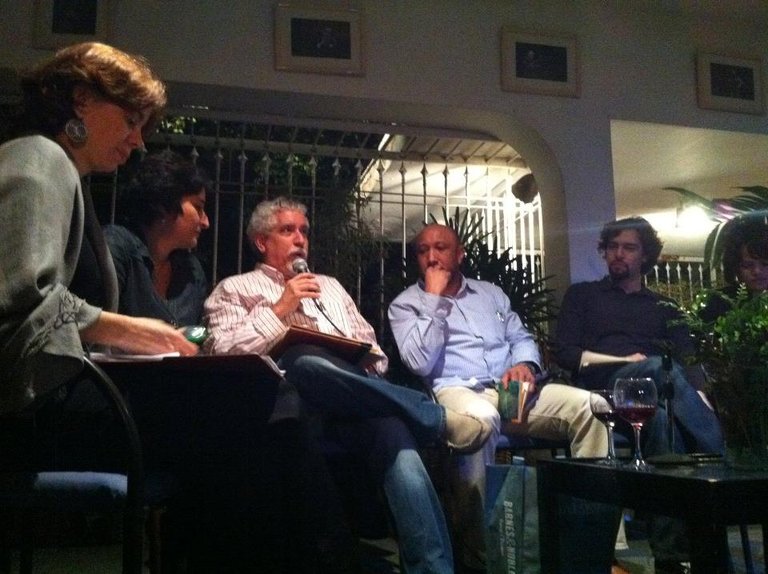
Poetry Jamming Ateneo de Caracas, 2011
That night I was surprised to see Enza among the participants, I had read about her as a young storyteller who had won prizes, but I did not know that she also wrote poems. That day, and in other recitals in which I heard her read in those years, she seemed to me a young rebel, who despite her girlish face, which she still keeps even though she is not so young anymore, talked about sex, her body, her experiences, her doubts in front of a world full of stereotypes and prejudices, with an honest, direct voice.
(...)
I'm afraid of being a woman
and that one day I might
to buy me some big tits
that I will do with my eyes
and the sweat accumulated in the wagons
what shall I do with the poor illusions of parents
who expect everything from the kingdom to come.
What will I do with the beautiful plasticized winter
that I have
in a corner of the house
where I left the sharpness
where the bathing suit
where the whore's face
where
I can breathe
and not owe explanations
where is time
that irreversible purpose
barely obedient
to the touch of itself.
I am afraid to open the door
I am afraid to be a woman
I'm afraid that talking
will get me nowhere.
( “The intact animal”)
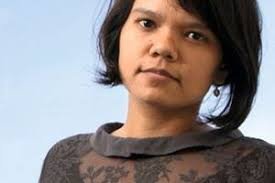
Photo sent by the author
One of the things that have befriended me with Enza García Arreaza's work is the synergy between poetry and visual arts. Both in her first book "El animal intacto" (2015) and in "Cosmonauta" (2020) we can enjoy that synergy. In the first one, we find a beautiful illustrations made by the written, in black and white. In the second, the texts, some in prose, others in verse, are accompanied by color collages, which resize the literary texts. In both books, both languages dialogue, creating a universe of their own that stimulates the reader's imagination and creativity.
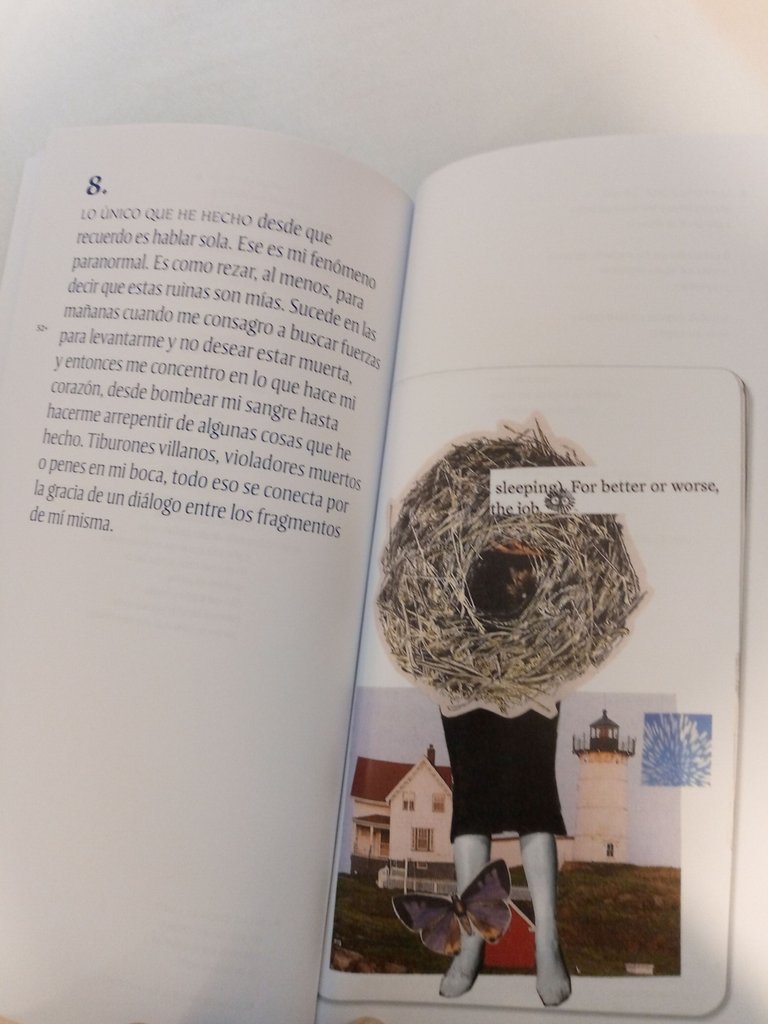
Photo from the book "Cosmonaut" taken with my cell phone camera.
The Mother

In her first book "The intact animal", published in 2015 by the Colombian publishing house Isla de Libros, we find some themes that are going to be central in her personal poetics, one of them is the theme of the mother. In "The intact animal" she talks about the mother in a generic sense, and in "Cosmonaut”, published by La Poeteca de Caracas in 2020, the poet presents us with a more personal vision of the mother, she makes reference to her mother. In any case, the representation of the mother in her poetry is always out of the stereotype, she is not the loving mother who cares and protects, she can even be aggressive, the mother represented in "Cosmonaut” is:
“All mothers
are a bit like William Blake
because to be a mother is to have visions
and to trade with the dismal angels
I thought that one should respectfully distrust
of that woman who opened up
to leave you alone in the world".
(“The intact animal”)

"Mom used to hit me in the face when I was a little girl. It was the time of her high sandals and looking pretty. If she was in a bad mood, anything would set her off and it would end with me getting a spanking. It was exhausting, especially holding back the urge to cry in the street. Maybe that's why sometimes, still, I don't like to talk tough and I stumble in the most ridiculous way even in my mother tongue."
(“Cosmonaut”, p. 13)
“Mom loves
making noise in the kitchen
the concept of bataqueadera
was coined by her
it is curious
that for someone with
with determined migraines
she doesn't know how to contain herself
knocking down doors or smashing pots and pans
coughing for everyone to see”
( “Cosmonaut”)
The animal inside us

As we all know, thanks to psychoanalysis, society, but also our unconscious, represses our animal, instinctive side. In her work the written shows us that certain voracity that underlies human relationships ("man is the wolf of man"). She does it with a certain irony. There is no victimization when she refers to that animal, predatory or violent side. He expresses it as someone who simply states and exposes an experience. In both books he plays with those figures, ghosts or fears that inhabit the labyrinths of our unconscious. He tells us in "The intact animal":
Those who love you to be alive
are sometimes afraid
alive is siege
alive can be wild

Photo from the book "The intact animal" taken with the camera of my cell phone.
Dear Enrique[z]:
A fox is a fire for those who forgot to look for water. Every color is a triumph of the eye over anomie. But am I deceived or are there really rites to keep the darkness from growing too much? The puffer fish draws circles in the sand to conquer the female. If I were a puffer fish I would draw a square: I don't know if I want to be chosen or deciphered. For centuries we have believed that butterflies inhabit our stomach when we jump. Meanwhile, darkness protects the prestige of hurried and tenacious animals. To be calm is to ignore that fires, angels and perfumes are sought in a chastisement, in a rare faith on the page.
(“Cosmonaut”)

Photo from the book "Cosmonaut" taken with my cell phone camera.
After laughing at a strip by Liniers, in which Enriqueta can be seen imagining a whale in her bathtub -and not just any whale but Moby Dick- I remembered with a start that when I was a child I used to play that if I suddenly turned around at shower time, I would find a shark sprouting from the wall with its mouth open, with all its bloodthirsty teeth hungry for me.
The craft of writing

Another reference that I want to highlight in Enza García Arreaza's poetry, because it is reiterated in her two published books, is the reflection on the very act of writing, the link between reality and the poem, reality can be people, objects, pets, but also the ghosts that inhabit us, as any reference of our personal reality can be transformed into a poem, a text, and configure our poetic imaginary:

Photo from the book "Cosmonaut" taken with my cell phone camera.
"because we sow a soul
in the solitude of objects
and we offer a song
to the hero of lesser lineage".
(“The intact animal”)
"Books are not shields
but
it happens to me that I write
about things I don't believe
I invoke ghosts
of corrosive hooting
and I become attached to childish certainties
and monstrous certainties
I often recall in my books
how we lose our sanity
in the face of our own fauna".
(“The intact animal” )
"You deserve that I think about the poem
before I write it.
You deserve an intact animal
who has been convinced
at last."
(“El animal intacto” )

Photo from the book "The intact animal" taken with the camera of my cell phone.
"Most of the stories I sketch don't make it to paper or screen, they are content to run in that cyclothymic blender that is my inner self. I can swear that I have written several masterpieces on the bus that takes me from the supermarket to the house, on those rare days when I am not murdered or robbed, but they melt away in some oblivion; I am left only with the certainty of having been someone else, of having lived an enviable delight in silence. Perhaps writing is nothing more than the fallacious euphemism for isolation, even when one is desperate for attention".
(“Cosmonaut”)

Photo from the book "Cosmonaut" taken with my cell phone camera.
"But then sometimes I tell a very long story that is always the same but always suffocates me and it's because I can't move. Writing, in me, is negotiating the air with paralysis and the world. It is also fighting against boredom or laziness, and lately against the feeling that this part of my life is ridiculous in front of that other part of my life where I am running for my life in a country without antibiotics or democracy.”
(“Cosmonaut”)
Not everything is cruel siege of the real in the poetry of Enza García Arreaza, suddenly she surprises us with a poem of deep lyricism that speaks of love, intertwining the living that transforms, without losing its essence, "the guitar" that "first was forest":
The guitar was first a forest
wood clinging to the trembling earth of the tribes
orbit of the caterpillar and the bird
will the wind know among the dawning fruit
how much nest it will have saved from prey
the guitar was first solitude and enclosure
but the serpent's ministering tune
wanted to ripen quickly the paradise
and so the string invented the bonfire or the barbarism
the curve of the female the cantata of the defeated one
the guitar was the spirit distributing the humidity
and sat us next to the pollen.
(for Leonardo González-Alcalá)

Dear reader, to close this article on the poetic work of Enza García Arreaza I share with you an unpublished poem that the author was kind enough to send me:
james is at work
I'm accompanied by the smell of my flatulence
and some emails to answer
sometimes i want the house to be haunted
i don't know what's wrong with the water in this country
that james came home from work
and found me possessed and said
now they're really going to make a movie about us.

Did you know her work? I hope you enjoyed them. You can download her book "Cosmonauta" for free on the website of La Poeteca de Caracas www.lapoeteca.com and you can follow the poet on her instagram account, although there she mainly shares her passion for photography
@enzagarciac
Bibliography consulted
García Arreaza, Enza. “El animal intacto”. Bogotá: Ediciones Isla de Libros, 2015.
García Arreaza, Enza. “Cosmonauta”. Caracas: La Poeteca de Caracas, 2020.
https://eldienteroto.org/wp49/enza-garcia-arreaza-una-semblanza-de-su-vida/
In the following link you can listen to Enza García Arreaza reading her book "Cosmonaut":
https://lapoeteca.com/libros-fundacion-la-poeteca/audiolibros/cosmonauta/
Translation to english by deepl.com
